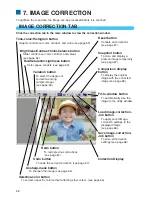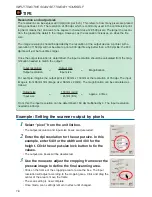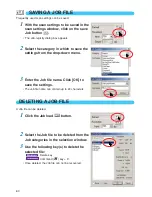
66
SELECTIVE-COLOR CORRECTIONS
Selective-color correction is an advanced technique to refine the colors in the image. The color of
each process color, cyan, magenta, yellow, and black, can be used to adjust the six separate color
groups in the image: red, green, blue, cyan, magenta, and yellow. This type of correction is effective
in changing a specific color without influencing any of the other colors in the image. For example, if
the sky looks purplish instead of blue, magenta can be reduced in the blue color group.
1
Click the selective-color button
.
2
Click the arrow next to the color list box to
select the color group.
3
Drag a slider or enter a value in a text box to
adjust the selected color.
• More than one slider can be used to adjust the selected color.
• Changes will be reflected in the prescan image.
• Click the reset button to cancel any changes.
UNSHARP MASK
The unsharp mask sharpens edges in the image without affecting overall image contrast. This mask
can be used with soft or slightly out-of-focus images. The effect of the unsharp mask is very subtle,
but makes a significant improvement to the overall appearance of the image.
1
Click the unsharp-mask button
.
• The unsharp-mask dialog box appears.
2
Drag a slider or enter a value in a text box to
adjust the parameters of the mask.
• The effect of the unsharp mask cannot be viewed in the
prescan image. It will only be seen in the final scan.
• The result of the unsharp mask differs with image resolution.
Make several scans with slight changes to the settings until
the settings produce the intended result.
• Clicking the reset button restores the default settings.
•
Amount:
can be adjusted between 0% and 500%. Adjust the slider to increase level of
contrast. If the value is too high, pixelation (the image becomes noticeably rough or grainy)
will be apparent. 150% to 200% is recommended for highly quality printed images.
•
Radius:
can be adjusted between 0.1 and 5. The default setting is 1. Adjust the slider to
increase the edge sharpness of the pixels. 1 to 2 is recommended for highly quality printed
images. Changes to the radius are more apparent on printed images, than images displayed
on a monitor.






























